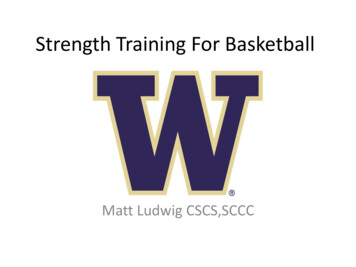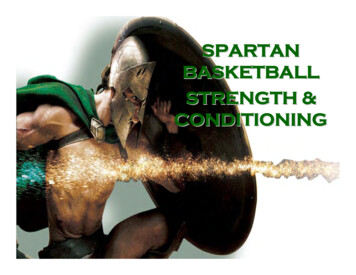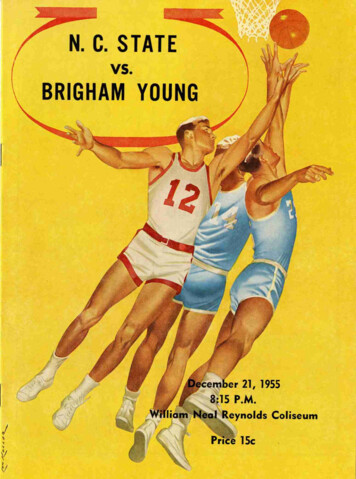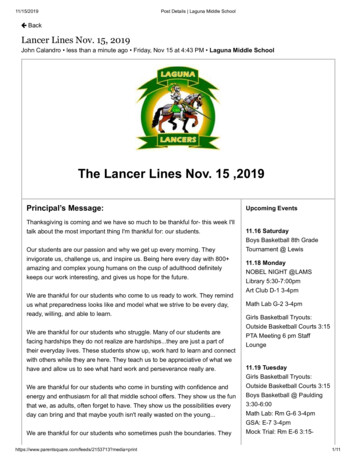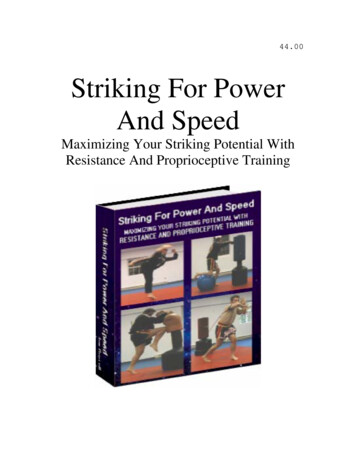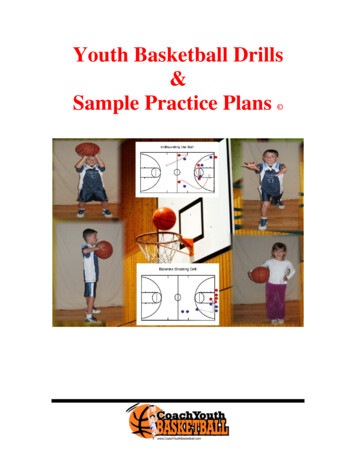
Transcription
Youth Basketball Drills&Sample Practice Plans
Table of ContentsINTRODUCTION . 1STRETCHING & WARM UP . 1LEG STRADDLE. 1TOE TOUCHES . 2QUAD STRETCH . 2HURDLER STRETCH . 2KNEE-TO-CHEST. 2COORDINATION & CONDITIONING DRILLS. 41.2.3.4.5.6.7.8.9.10.11.12.CIRCLE BASKETBALL AROUND WAIST. 4CIRCLE BASKETBALL AROUND LEGS . 4THROW BALL IN AIR & CATCH . 4THROW BALL IN AIR, CLAP & CATCH . 5GASERS OR LINE RUNS . 5STUCK IN THE MUD DRILL . 5BOX RUN RELAY . 6SPRINT – JOG RUN . 6SPRINT PAST THE PACK RUN . 7“COACH SAYS” . 8RELAY RACES . 8CATCH THE TIGER’S TAIL . 8DRIBBLING DRILLS . 1013.14.15.16.17.18.19.20.21.22.23.24.25.RIGHTY – LEFTY DRILL . 10DRIBBLING AROUND CONES . 10DRIBBLE AROUND DEFENDERS DRILL . 11ONE ON ONE DRIBBLING . 12HALF COURT LAY UP RELAY . 123 PLAYER WEAVE DRILL . 13FOLLOW THE LEADER. 14SHARKS & MINNOWS . 14SPACE MAN DRILL . 15ENGINE & CABOOSE DRILL . 16CHANGE DIRECTION DRILL . 16HEAD UP DRIBBLING . 16RED, YELLOW, GREEN, PURPLE LIGHT. 17PASSING DRILLS. 1826.27.28.29.30.31.32.33.34.35.PARTNER PASS . 18TRIANGLE PASS & RECEIVE . 18MONKEY IN THE MIDDLE DRILL. 18PASSING RELAY RACE. 19FAST BREAK PASS DRILL . 19MOVE THE STICK PASSING DRILL . 20QUICK BACK & FORTH PASS DRILL . 21SHUFFLE PASS RELAY . 21PASS IT DOWN THE LINE DRILL . 22TOUCH DOWN PASS DRILL . 23
36.GIVE & GO / PASS TO COACH DRILL . 23SHOOTING DRILLS . 2437.38.39.40.41.42.43.44.45.DRIBBLE DOWN AND SHOOT DRILL (JUMP SHOT) . 24AROUND THE WORLD . 24PIG, HORSE, ELEPHANT (OR ANY OTHER ANIMAL) . 252 ON 1 SHOOTING DRILL . 253 ON 3 SHOOTING DRILL. 2610 BASKET TEAM SHOOTING. 26LOW POST SHOOTING DRILL . 27HEAD FAKE & GO (OR SHOOT) DRILL . 27BASE LINE SHOOTING DRILL. 28DEFENSE DRILLS. 2946.47.48.49.50.DEFENSE SHUFFLE . 29TRAP DRILL. 29MIRROR DRILL . 301 ON 1 DEFENSE. 302 ON 2 DENY DEFENSE . 31REBOUNDING DRILLS. 3251.52.53.54.BOX-OUT DRILL. 32FOUL SHOT BOX-OUT DRILL. 32“FIND” & SEEK BOX-OUT . 33ONE ON ONE ON ONE .DRILL . 34OTHER DRILLS. 3555.56.57.PICK SETTING DRILL . 35INBOUNDING THE BALL DRILL. 35FAST BREAK OUTLET DRILL . 36PRACTICE SAMPLE 2. 39PRACTICE SAMPLE 3. 40PRACTICE SAMPLE 4. 41PRACTICE SAMPLE 5. 42PRACTICE TEMPLATE FORM. 43OTHER BOOKS FROM COACHYOUTHBASKETBALL.COM . 44
Legal NoticesNo part of this publication may be reproduced or transmitted in any form or means, mechanical orelectronic, including photocopying or recording or by any information storage and retrieval system ortransmitted by email without the express permission of the publisher.While all efforts have been made to produce an accurate document, neither the author nor publisherassumes responsibility for error or omissions or contrary interpretation of the subject matter herein.CoachYouthBasketball.comCopyright 2004All Rights Reserved
Youth Basketball Drills & Sample Practice Plans IntroductionAs we have mentioned in the Coaching Youth Basketball book, all children, especially youngchildren have short attention spans. That’s what makes them children! It is your job as coach tokeep them focused and interested in what’s going on. Keeping a 5-8 year olds’ attention may bethe most difficult thing you will encounter in coaching.The best way to keep the players focused, is to have constant movement and change. Youshould attempt to have all the players involved with an activity/drill at the same time. That willcut down on the amount of time that a player is only standing around watching the other playersgo through the activity. The time that a player is not engaged in activity is the time you will“lose them”.Also, to keep everything new and exciting, each drill should last no more than 5-10 minutes.Gauge your team’s attention span and adjust the length of each drill accordingly.We have included a number of drills in this book so that you won’t find yourself running out ofthings to do.Stretching & Warm UpIt is very important to have a short 5-minute warm-up before you get into the heart of yourpractice. The warm-up should consist of stretching and light cardio exercises. The drills foundunder the Coordination/Conditioning Drills Section, can serve as good warm up exercises.Stretching is very important and will help loosen tight muscles and help prevent muscle injuries.Leg StraddleFor this stretch, the legs should be slightly more than shoulder length apart. The players shouldstart by attempting to touch the ground with their hands. On the coach’s command, the playersthen attempt to touch their right foot with both hands. Then, once again on the coach’scommand, players should switch and attempt to touch their left foot with both hands. Theplayers should then attempt to move their legs further apart and repeat the above actions.Remember to have the players keep their legs straight and not bend their knees.Page 1
Youth Basketball Drills & Sample Practice Plans Toe TouchesThis is a simple stretch where players stand straight with their legs together and feet flat on theground. The player then SLOWLY attempts to touch their toes while keeping their knees/legsstraight. The players should not bounce when attempting to touch their toes.Quad StretchIn this stretch, the players start from a standing position. Balancing on one foot, the players griptheir foot and pull their leg up towards their back (see photo).Hurdler StretchIn this stretch the players start from a seated position extending one leg forward while having theother leg back (see photos). The players then lean forward, attempting to touch the foot of theleg which is forward. After a few seconds, the players should switch legs and stretch the otherleg. The players need to keep the leg which is forward, straight and not bend the knee.Knee-to-ChestIn this stretch, the players lay flat on their backs with their legs extended straight. On thecoach’s command, the players should bend one leg at the knee and bring their knee into theirPage 2
Youth Basketball Drills & Sample Practice Plans chest. After a few seconds, the players return the leg to the ground and then pull the other legtoward their chest.Page 3
Youth Basketball Drills & Sample Practice Plans Coordination & Conditioning DrillsBasketball is a sport of constant motion. If a player is not in the proper condition, they will findit difficult to keep up with other players, and the offense and especially defense will suffer. It isessential that your players be in good physical condition. While many younger players can runall day long and seem to never get tired, many children today are out of shape. Conditioningshould be part of every practice.1. Circle Basketball Around WaistPlayers stand facing the coach while holding their basketball with both hands, waist high.On the coach’s command, the player circles the basketball around their waist. After afew times, have the players stop and then circle the ball in the opposite direction. Thisdrill may seem very easy, but you will be surprised how difficult yet fun it is for smallplayers.2. Circle Basketball Around LegsThis is a variation of the “Circle Basketball Around Waist Drill” Once again, the playersstand facing the coach. On the coach’s command, the player circles the basketball in andout of their legs in a figure 8 pattern. Have the players stop and then circle the ball in theopposite direction.3. Throw ball in air & catchIn this drill the players stand facing the coach, holding their basketball with both hands,waist high. On the coach’s command the players throw the ball up in the air and thencatch it. Have the players start by throwing the ball up only a foot or two into the air.Once they master this, have the players increase the height of the throw.Page 4
Youth Basketball Drills & Sample Practice Plans 4. Throw ball in air, clap & catchThis is a variation of the previous drill with some added complexity. Simply add a clap.The players are to throw the ball in the air, clap, and then catch the ball. Have the playersthen increase the height they throw the ball AND have them increase the number of clapsbefore the catch.5. Gasers or Line RunsIn this drill, all the players line up at one end of the court. On the coach’s, command, allplayers proceed to run: 1) as far as the nearest foul line and back, 2) to ½ court and back,3) to the furthest foul line and back, and 4) to the opposite end of the court and back.This drill is sure to help build a player’s conditioning and endurance.6. Stuck in the Mud DrillDesignate a boundary area on the court where all the action will take place (usually onone half of the court). All players must stay in this area. Designate 1-2 players that are“it”. At the start of this drill, all the players that are not “it” will begin to run and avoidthe “it” players. It is the “it” players’ job to tag the other players. When a player istagged, the player is “stuck in the mud” and must stand still. The stuck player can getunstuck when another player crawls under his/her legs. The game ends after a certaintime has elapsed or when all the players are stuck in the mud. This game can be donewith or without using the basketball.Page 5
Youth Basketball Drills & Sample Practice Plans 7. Box Run RelayFor this drill, divide your team into equal teams. On the coach’s command the firstplayer from each team will shuffle down the baseline. Once they reach the corner of thecourt, the players will then back pedal to half court. At half court the players will thenshuffle to the jump ball circle. Once they reach the jump ball circle, the players willsprint back to the starting line, tagging the next player who then continues the relay.8. Sprint – Jog RunThis is a simple conditioning drill where your players sprint to half court and then jog therest of the way. You can change this order to a jog and then sprint if you want.Page 6
Youth Basketball Drills & Sample Practice Plans 9. Sprint Past the Pack RunIn this drill, have your entire team line in a straight line outside the court. The team is tojog around the exterior of the court. On the coach’s command the player at the end of theline should sprint to the front of the line (passing the other players). At each commandthe new player at the end of the line sprints to front. This continues until all players havehad an opportunity to be the last in line (and sprint to the front).Page 7
Youth Basketball Drills & Sample Practice Plans 10. “Coach Says”This is a way to break away from the traditional basketball drills. It teaches players tolisten and to pay attention. This drill is just like the game “Simon Says”; however,instead of Simon it is “Coach Says”. The players only react to the coach’s commands ifthe coach starts the command by saying “Coach Says ”. (example “coach says tohop on 1 foot’) When a player reacts to a command that does not start with the statement“Coach Says” then that player is out and must sit down until the game is over. The lastplayer in the game is the winner.11. Relay RacesDepending on the number of players on your team, break your team into 2 or 3 groups.From a starting point, mark out a point 25-30 yards down field. The players must go fromthe starting point, around the cones (25-30 yards down field) and back to the starting line,tagging the next player who then races downfield next. Once a player is done, the playergoes to the end of the line and sits. The first team that has completed the race and has allplayers sitting is the winner.There are numerous things that can be done in these races: Running Hopping (on 1 foot or both feet) Skipping Dribbling the basketball12. Catch the Tiger’s TailIn this drill, 1 Player is “Rabbit” or “Tiger”. For this player, put a shirt or Pinnie into theback of their shorts. Make sure that it sticks out of their shorts (resembling a tail).Section an area of the field that is in bounds. The object of this drill is to have the otherplayers chase the “Tiger/Rabbit” and pull out the tail. Remember to give the “Rabbit” or“Tiger” a bit of a head start. The player that catches the “Tiger’s tail” will be designatedas the next “Tiger”.Page 8
Youth Basketball Drills & Sample Practice Plans Page 9
Youth Basketball Drills & Sample Practice Plans Dribbling DrillsOne of the most difficult things for young players to do is to control the ball. When dribbling abasketball, most new players kick the ball too hard, causing the ball to go too far away fromthem; therefore, losing the ball to another player. The key to proper ball control is to have theplayer keep the ball at a close distance while running in the direction that they want to go.13. Righty – Lefty DrillAll the players can do this drill at the same time (if you have enough basketballs).For this drill, have the entire team line up at one end of the court. On the coach’scommand the players are to dribble to half court with their Right Hands. Once theplayers pass half court they should switch hands and dribble the rest of the way withtheir Left Hand.14. Dribbling Around ConesThis is a simple drill that helps develop ball control and coordination. Divide your teaminto 2-3 groups. Each group lines up in a straight line. Setup cones every 5 yards (3-4cones per group should be fine for this age group). Then on the coach’s command, havethe players dribble around the cones. Variations of this drill: have the player shoot at thebasket when they pass the last cone, or make the game into a relay race, the first team tofinish dribbling through the cones, shoots and then sits in a straight line wins the game.Page 10
Youth Basketball Drills & Sample Practice Plans 15. Dribble Around Defenders DrillFor this drill, have a number of players (depending on your area and the spacing youwant between the defenders) line up straight down the middle of the court. Theseplayers will be the defenders. The defenders can not move their feet, but can movetheir hands and lean for the ball. The defenders should have their hands up at alltimes. The ball handlers will dribble the ball between the defenders in a weaving likepattern. The goal is for the ball handler to successfully get to the other side of thecourt without losing control of the ball or having the ball touched by the defense.Page 11
Youth Basketball Drills & Sample Practice Plans 16. One on One DribblingFor this drill, have the players pair up. Each pair has 1 basketball. One player from eachgroup starts on the base line with the ball (this group is on offense). The other grouplines up approximately 3 feet away and they are on defense. The object of the game isfor the offense to dribble the ball to the half court line. The goal for the defense shouldbe to steal the ball or stop the dribble of the player on offense.17. Half Court Lay up RelayFor this drill, divide your team into 2 groups. Each group lines up in a straight line athalf court and the first person in each group has a ball. At the coach’s command, the firstperson in each group dribbles down court towards the basket and shoots a layup. Aftermaking the shot (or after 2 attempts at making a shot) the players rebound their basketballand dribble back to half court, passing the ball to the next person in line. The nextplayers in line then repeat the drill, until all have had a turn.Page 12
Youth Basketball Drills & Sample Practice Plans 18. 3 Player Weave DrillThis is a more advanced drill. Three players start lined up across the court. The player inthe middle starts with the ball (Player 1). Player 1 then passes the ball to the player onthe right (Player 2). Player 1 then runs to the right side of the court while Player 2 goesto the middle of the court. Player 2 then passes the ball to the player on the left side ofthe court (Player 3). Player 2 then runs to the left side of the court while Player 3 goes tothe middle of the court. Player 3 continues to dribble and then shoots a layup.Page 13
Youth Basketball Drills & Sample Practice Plans 19. Follow the LeaderThis drill can be done with or without the basketball. In this game, have your entire teamline-up in a straight line behind the coach. The players are to do exactly what the coachor designated “leader” is doing. Without the basketball the coach can: Hop, Jump, Skip,Run with legs high, etc. With the basketball the coach can: Dribble the ball with theirright hand, with their left hand, dribble while walking backwards, cross-over dribble, etc.20. Sharks & MinnowsFor this game, designate an area on the court for play (usually half court). All playersmust stay within this designated area. Start with one player designated as the “Shark”.The rest of the players are the “Minnows”. The object of the “Shark” is to kick the ballaway from the “Minnows” (the ball needs to be kicked out of the designated area ofplay). Once a “Minnow” has their ball kicked away, they then become “Sharks”, andattempt to take the ball away from the other “Minnows”. At the start of the game the“Minnows” should be on the run trying to avoid the “Sharks” AND maintaining ballcontrol. The game ends when there is only 1 “Minnow” remaining. This is also a greatdefensive drill.Page 14
Youth Basketball Drills & Sample Practice Plans 21. SPACE MAN DrillEvenly space players around square boxed area. Have players dribble around the area,maintaining ball control. The players should also have their heads up. The goal to thisdrill is for players to maintain ball control and maintain the same distance apart fromeach other as from the start of the drill.Page 15
Youth Basketball Drills & Sample Practice Plans 22. Engine & Caboose DrillThis drill is somewhat like the “Space Man Drill”. Players pair up and each player hastheir own ball. Each pair of players is a “train”. One player will be the Engine and theother will be the Caboose. The Engine player is in front and the Caboose player lines up1-2 yards behind the Engine Player. On the coach’s command, the players should dribbletheir basketballs around a designated area. The object of the drill is to maintain ballcontrol and for the players to stay within the same distance (1-2 yards) of each other asthey were at the start of the game.23. Change Direction DrillThe object of this game is for the players to “sneak up” behind the coach while the coachhas his/her back turned. However, if the coach turns around the players must reversedirection and run back to the starting line. To start this game, the coach turns his/herback to the team and begins to walk up field. As the coach’s back is turned, the playersshould dribble their basketball down court after the coach (while maintaining control ofthe basketball). The coach should then turn to face the players and chase them back tothe starting line. Once the coach turns, the players should Stop, Reverse Direction andquickly dribble the ball back to the starting line.24. Head Up DribblingThis drill works on the player’s ability to dribble with their head up. Each player hastheir own ball. The players are to dribble the ball while keeping their head up andlooking at the coach. The coach will make hand motions (no talking) signaling what theplayers should do next.Page 16
Youth Basketball Drills & Sample Practice Plans 1 Finger can stand for dribble with Right Hand2 Fingers mean dribble with Left HandCoach pointing to Right means dribble to the RightCoach pointing to Left means dribble to LeftCoach pointing Forward means dribble ForwardCoach pointing Backwards means dribble backwards25. Red, Yellow, Green, Purple LightThis game will help dribbling, coordination AND listening skills. Each player has theirown ball and dribbles around the court maintaining ball control and remembering to keeptheir head up. The coach then calls out a command (“Red Light”, “Green Light”, “YellowLight”, or “Purple Light”) and the players should react accordingly. Red Light – Means Stop. The players dribble the ball while standing in oneplace. Green Light – Means Go. The players move quickly around the court whiledribbling the ball; but in control. Yellow Light – Means Slow Down. The players move slowly with the ball. Purple Light – Means - Stop dribbling the ball, place the ball on the ground, thenafter the ball has stopped, the players run around the ball in a circle.All different variations can be used in this drill.Page 17
Youth Basketball Drills & Sample Practice Plans Passing DrillsGood fundamental passing is becoming a lost art form in basketball. However, the team that canproperly pass the ball and find the open man will be the team that puts themselves in a betterposition to score. You may find that players do not want to work on passing drills. Manyplayers feel they are boring and want to practice shooting. However, instill in your players thatto get in the best position to shoot, they first must learn to pass.26.Partner PassHave the players pair up with a partner. The pairs should line up approximately 3-5 feetapart from each other (depending on skill level). Facing each other, the pair should passthe basketball to each other. Start with the chest pass then move onto the bounce pass.Emphasize good passing fundamentals.27. Triangle Pass & ReceiveDivide your team into groups of 3 players. Have each group form a triangle. Start byhaving your players pass the ball to each other in a clockwise rotation. Then have theplayers switch directions and pass to each other in a counter-clockwise direction. Onceagain, emphasize proper passing.28. Monkey in the Middle DrillThis game will help your players develop passing skills. Have your
Throw ball in air, clap & catch This is a variation of the previous drill with some added complexity. Simply add a clap. The players are to throw the ball in the air, clap, and then catch the ball. Have the players then increase the height they throw the ball AND have them increase the number of claps
